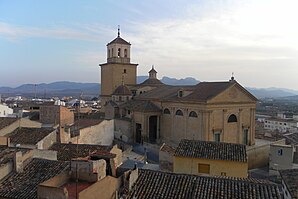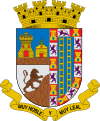Jumilla (city)
| Jumilla parish | ||
|---|---|---|
 Jumilla - View of town with Iglesia de Santiago
|
||
| coat of arms | Map of Spain | |

|
|
|
| Basic data | ||
| Autonomous Community : |
|
|
| Comarca : | Altiplano (Murcia) | |
| Coordinates | 38 ° 29 ′ N , 1 ° 20 ′ W | |
| Height : | 500 msnm | |
| Area : | 972 km² | |
| Residents : | 25,600 (Jan. 1, 2019) | |
| Population density : | 26.34 inhabitants / km² | |
| Postal code : | 30520 | |
| Municipality number ( INE ): | 30022 | |
| administration | ||
| Website : | Jumilla | |
Jumilla is a city and a municipality (municipio) with 25,600 inhabitants (as of January 1, 2019) in the north of the southeastern Spanish region of Murcia . The old town center was classified as a cultural asset ( Bien de Interés Cultural ) in the Conjunto histórico-artístico category.
location
The city of Jumilla is a good 70 km (driving distance) northwest of the city of Murcia at an altitude of approx. 500 m . The climate in winter is temperate, while in summer it is warm to hot; the low amounts of precipitation (approx. 370 mm / year) fall - with the exception of the almost rainless summer months - distributed over the whole year.
Population development
| year | 1857 | 1900 | 1950 | 2000 | 2017 |
| Residents | 10,611 | 16,446 | 20,851 | 20,854 | 25,672 |
The continuous increase in population since the middle of the 19th century is mainly due to the ongoing immigration from the rural area. Several hamlets (pedanías) and individual farms (fincas) also belong to the community .
economy
For centuries, the region around Jumilla was oriented towards agriculture - in addition to the cultivation of grain (especially barley and wheat ), numerous almond and olive trees and vines were planted as early as Roman and Moorish times . Small traders, craftsmen and service companies of all kinds have settled in the village.
history
Prehistoric, Iberian and Roman traces have been discovered in the municipality; Visigoth finds, however, are sparse. In the 8th century the area was overrun by the Moors , who in the 13th century in the course of the Christian reconquest ( reconquista ) under Ferdinand III. of Castile (ruled 1230–1252) initially made tribute and in 1266 his son Alfonso X. of Castile (ruled 1252–1282) could be driven out of the region around Murcia. Due to family disputes after the death of Alfonso X, the kingdom of Aragón temporarily took over the rule between 1296 and 1304; this policy of interference was continued in 1232 by James I of Aragon and a decade-long conflict arose between Castile and Aragon over the Kingdom of Murcia . In 1445 Jumilla came under the manorial rule (señorio) of the leading house of Villena in the region, with whom it remained until the 19th century. After that of Philip III. (r. 1598–1621) and his first minister, the Duke of Lerma , ordered the expulsion of the Moors at the beginning of the 17th century, the population of the place declined significantly.
Attractions
- The castle (castillo) rises on the site of a Bronze Age and Iron Age fortress or settlement, which was surrounded with a wall after the conquest by the Romans . In the 9th or 10th century, a Moorish fortress was built, which in 1241 by the troops of Ferdinand III. was taken. The current castle with its brick keep (torre del homenaje) largely dates from the middle of the 15th century.
- The construction of the Iglesia de Santiago began in the 15th century, when the majority of the population had already moved from the castle hill to the present city. However, it was not completed until the 18th century. The three-aisled church has a three-conch choir , which is unusual in Spain , a later added inner choir ( coro ) and an impressive altarpiece (retablo) from the 16th / 17th centuries. Century.
- The two-tower Iglesia del Salvador was built in the second half of the 18th century. The interior has a single nave with a transept and an illuminated crossing dome .
- The building called El Casón was an early Christian tomb from the 5th century; it used to stand in the middle of two Roman villas.
- The city's Museo arqueológico is located in a representative palace from the 16th century .
- Surroundings
- A statue of the Virgin Mary (Nuestra Señora de la Asunción) is venerated in the Ermita de San Agustín , built in the 16th century about 1 km outside the city .
- About 10 km south of the city is the Santa Ana del Monte monastery , which was built and expanded from the 16th century by a Franciscan reform order on the site of an older hermit church. The building complex also includes a small museum with religious art.
- Another 15 km south are the well-preserved remains of a Roman dam (Presa Romana de Román) .
Web links
- Jumilla, sights - photos + information (Spanish)
Individual evidence
- ↑ Cifras oficiales de población resultantes de la revisión del Padrón municipal a 1 de enero . Population statistics from the Instituto Nacional de Estadística (population update).
- ↑ Jumilla - climate tables
- ↑ Jumilla - population development
- ↑ Jumilla - Economy etc.
- ^ Jumilla story
- ↑ Jumilla - Castillo
- ↑ Jumilla - Iglesia de Santiago
- ↑ Jumilla - Iglesia del Salvador
- ↑ Jumilla - El Casón
- ↑ Jumilla - Museo arqueológico
- ↑ Jumilla - Ermita
- ^ Jumilla - Convento de Santa Ana del Monte


